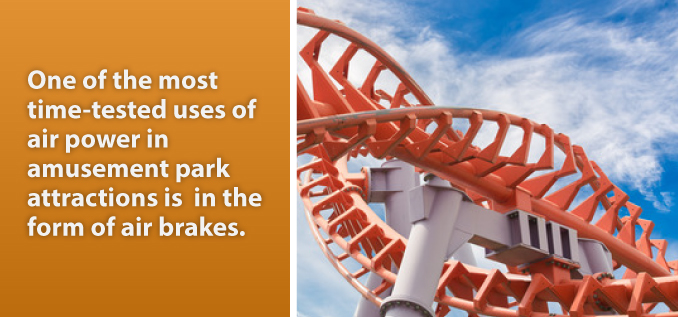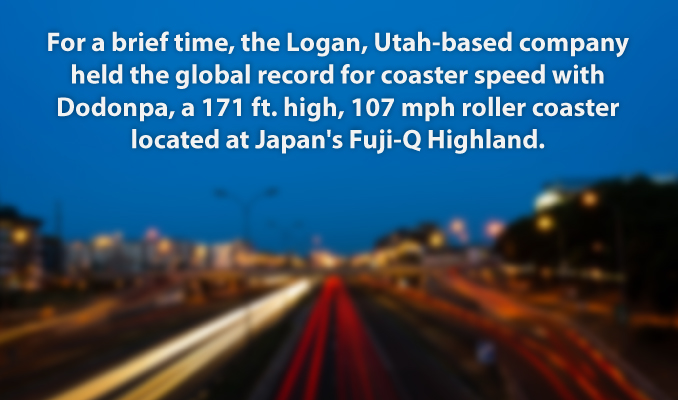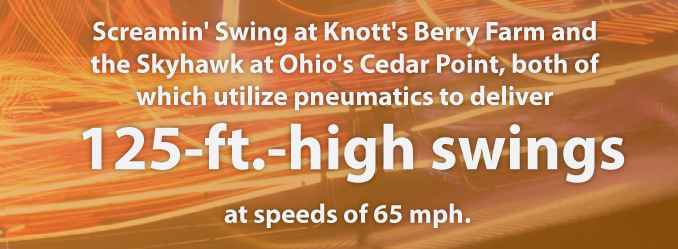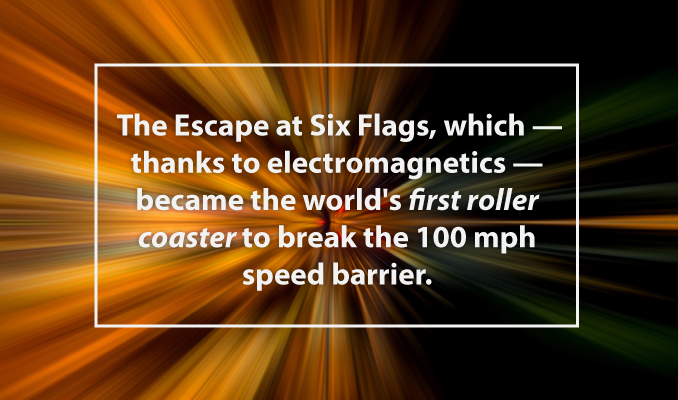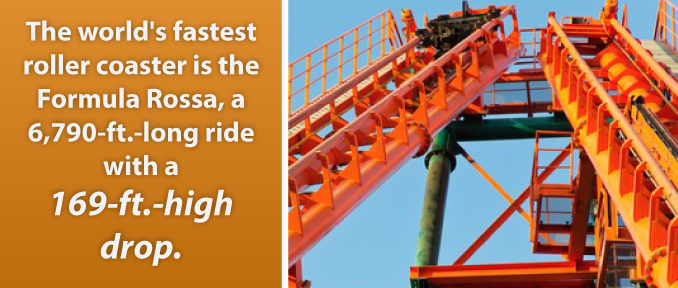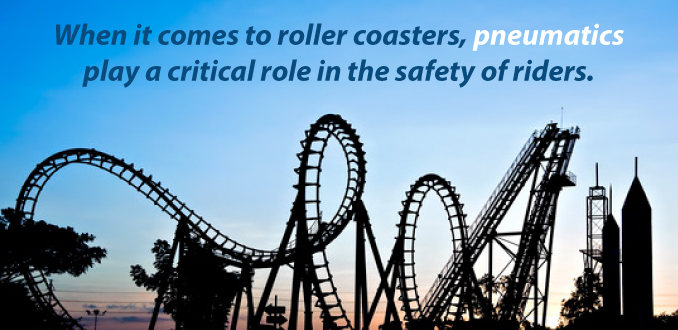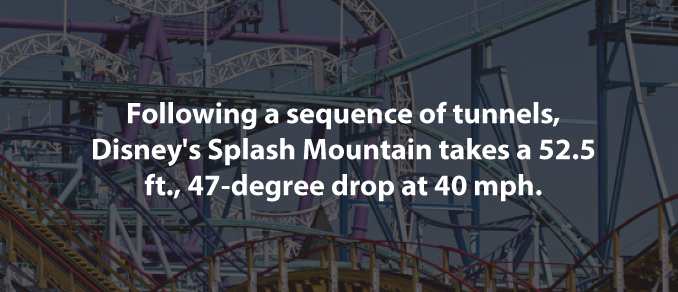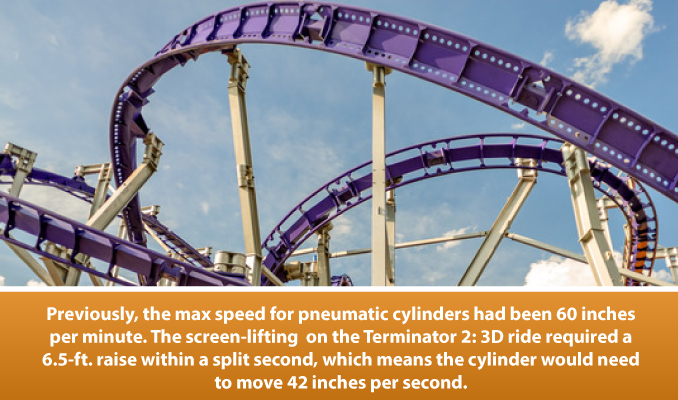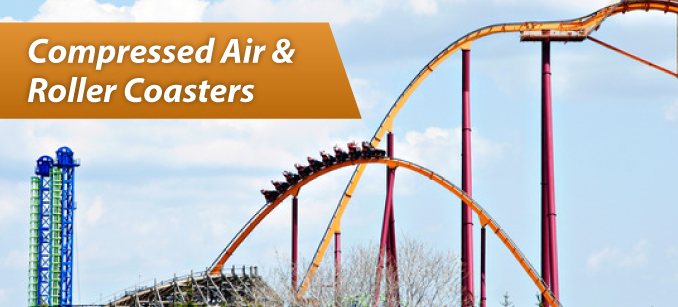
Amusement parks offer a joyous sensory overload for people of all ages. From the sweet taste of cotton candy to the colors and visuals of the roller coasters and Ferris wheels, amusement parks stimulate the eyes and taste buds, as well as the imagination. Above and beyond all of the side attractions, however, is the physical thrill that comes with the brisk turns and plunges of the actual rides.
Whether a visitor experiences rides for the first or tenth time, there is no rush of adrenalin that compares to the experience of being plunged from heights that exceed 100 feet at speeds of more than 100 miles per hour. What most visitors don’t realize is the crucial role that air compressors play in the power, performance, and overall feel of the most harrowing rides — roller coasters in particular.
Roller Coaster Compressed Air Systems
At amusement parks, compressed air is utilized in ways that are unknown to most visitors, yet the methods used are integral to the safety of people in all age groups who come to brave some of the world’s wildest rides. With the employment of airgates, amusement parks keep visitors safe while waiting to board the rides.
Airgates
From underneath the rides, operators control the process with a switch, which causes queue gates to open and shut with a pressurized single cylinder. Though it may be disconcerting to park-goers — children in particular — when the operators tell people not to lean against the airgates, the function they serve is crucial to amusement-park safety.
Air to Add to the Experience
In many rides, air is employed to make the experience seem more realistic, such as in the anti-gravity portion of the Spiderman attraction, where wind is blown as the stages get lowered in order to make riders feel like they’re being launched into the air.
In rides that feature sequences, which need to seem faster than mechanically possible, fans and turbines are used to mimic the feel of brisk, opposing winds. With proper engineering, compressed air also allows for superior cushioning in drives, from the open-and-shut functions of valves, to the speedup and slowdown of motion profiles.
Air Brakes
One of the most time-tested uses of air power in amusement park attractions is for roller coasters in the form of air brakes, which are used at rides throughout the U.S. With air brakes, compressed air is streamed from a tank in order to create friction between the metal plates on which the coaster runs. Design-wise, it’s all straightforward enough, though a coaster can run a bit past its stopping point if the sensors don’t activate at the right second.
On brake runs — the part of a coaster track that’s designed to bring the coaster to a stop — air is used for control purposes in certain magnetic brake systems. Swiss thrill-ride maker Intamin has used this combination on a variety of hypercoasters and hydraulic-launch coasters, including the following:
- Intimidator 305 – at Kings Dominion in Doswell, Va.
- Kingda Ka – at Six Flags Great Adventure in Jackson, N.J.
- Skyrush – at Hersheypark in Hershey, Penn.
- Top Thrill Dragster – at Cedar Point in Sandusky, Ohio
- Xcelerator – at Knott’s Berry Farm in Buena Park, Calif.
On all of these coasters, the brake run is turned on and off by moving, actuator-mounted magnetic plates. When hydraulic rides like Dragster and Xcelerator are launched, the brakes are brought down from underneath so the coasters can advance from the brake run.
Air Actuators
Air actuators have also become more commonplace on dark rides, where the technology has powered the animation of props and animatronic figures, as well as ride vehicles. Examples of such rides include Curse of DarKastle, Spiderman, and Transformers, where air-controlled movements are employed to give riders a sense of riding on air.
One company that has galvanized the market of pneumatic-powered rides is S&S, which has put compressed air to use in nearly all of its attractions at amusement parks. For a brief time, the Logan, Utah-based company held the global record for coaster speed with Dodonpa, a 171 ft. high, 107 mph roller coaster located at Japan’s Fuji-Q Highland.
So far, the company’s only roller coaster in the U.S. has been the now-defunct Hypersonic XLC, which was open at Kings Dominion in Doswell, Va., from 2001 through 2007. Famed for its 133-ft. high, 90-degree drop, the 80-mph ride was scrapped due to repeated technical difficulties, which proved especially cost-prohibitive given the coaster’s low capacity. Nonetheless, S&S remains a much-revered maker of stateside attractions, including the Screamin’ Swing at Knott’s Berry Farm and the Skyhawk at Ohio’s Cedar Point, both of which utilize pneumatics to deliver 125-ft.-high swings at speeds of 65 mph.
Launch Systems: Pneumatics vs. Hydraulics vs. Electromagnetics
Traditionally, roller coasters have been elevated to the peak of their drops through the mechanisms of lift hills. But due to the amount of height and space consumption that lift hills necessitate, a growing number of amusement parks have been seeking alternate methods for raising rides.
The main alternatives in this regard are launch systems, where energy is contained as compressed air or electricity and moved quickly to the coaster through a system of propulsion, wherein the energy takes kinetic form. Launch systems vary in terms of how they generate power, but they include the following:
- Catapult
- Electromagnetic
- Flywheel
- Hydraulics
- Pneumatics
Roller Coaster Electromagnetics
Out of the other propulsion systems used at today’s amusement parks, electromagnetic is popular because of its easy-to-specify initial launch speeds. The electromagnetic system also has its drawbacks, namely the sharp declines in acceleration towards the end of each launch. The system relies on electrical impulses, which draw or decline a coaster’s magnetic fins. On roller coasters, electromagnetic systems fall into two categories:
- Linear induction motors (LIM)
- Linear synchronous motors (LSM)
LIM relies on several groups of electromagnets along the coaster path, where each group of magnets is split by a canal in the center. The coaster, meanwhile, is equipped with an underlying fin that slots into the groove of this canal. A magnetic field is generated through application of an AC electrical current onto the magnets. The magnetic field powers the launch by sending waves through the magnet canal, which propels the coaster into full speed within seconds. The first roller coaster to employ an LIM launch system, Flight of Fear, opened in 1996 at Kings Island in Mason, Ohio.
LSM functions on the standard means of magnetism: attraction and repulsion. Under this system, coasters are equipped with permanent magnets comprised of rare-earth alloys. Likewise, the tracks of the ride are lined with electromagnets, which draw the corresponding magnets of the approaching coaster forward. As each track magnet is passed, it reverses to negative to repel the train onward.
In order for the launch to take effect, every track-lined electromagnet must flip in succession. The LSM launch system is used for Magic Mountain’s Superman: The Escape at Six Flags, which — thanks to electromagnetics — became the world’s first roller coaster to break the 100 mph speed barrier.
Strong in nature and free of moving parts, the LIM and LSM electromagnet launching systems are capable of generating smooth, fast movements, but they do demand a lot of power, which ultimately has its limits when a current is being pumped exceedingly.
Heat is another factor that can test the limits of a launch, and heat only increases when the stationary parts of a rotary system have to work extra hard. A handful of external factors can also restrict the speed levels of a given ride, particularly if the stators are limited in number due to the size of a launch track.
Roller Coaster Hydraulics
With the hydraulic launch system, a coaster is powered from underside mechanisms that are joined to a sled via cable. The dual-compartment devices that store energy within the motor — which is placed at one side of the track — are pumped with hydraulic fluid in one compartment while gas compression takes place in the other. The pumping ceases as the compressed nitrogen gets hot, after which it’s sent to a cylinder block.
During the launch, the hydraulic motors are fueled by the compartment-pressurized fluid. Through a planetary gearbox, the collective motor power is sent to the cable drum. As the drum turns, the cable gets wound, which accelerates the sled in seconds flat. At this point, the coaster is freed to run the track. Meanwhile, the sled and drum slow down and get ready to start the whole process over again with the next coaster.
In most cases, there will be a pair of sensors attached at the peak of the nearest high point of the ride. At the control system, whatever distance exists between the sensors is divided by the time required to move from one to the other. The information for each launch is gathered by the computer for study along an overall performance curve. By averaging the speeds of the three most recent coasters in comparison to earlier groups of launches, the computer gauges the amount of power needed to fuel the hydraulic motor. This ensures that each coaster is given enough power to carry any possible load at the requisite speed, regardless of the heights and weights of the riders in a given launch.
In terms of speed and smoothness, hydraulic launch systems are generally viewed as preferable over electromagnetic ones, though each has its own pros and cons. On one hand, the hydraulic system offers near-perfect consistency during each step of a launch. Then again, hydraulics rely on numerous moving parts that raise the chance that something could malfunction, whereas electromagnetic systems don’t even use moving parts.
Hydraulics are responsible for what is currently the world’s fastest roller coaster: Formula Rossa, a 6,790-ft.-long ride with a 169-ft.-high drop that opened in 2010 at Ferrari World on Yas Island in Abu Dhabi, United Arab Emirates. Thanks to hydraulics, the ride is able to zip up to 149 mph in 4.9 seconds. Dodonpa, the prior record holder, uses a pneumatic launch to send riders from 0 to 106.9 in 1.8 seconds.
Hydraulic and pneumatic launch systems are similar to one another; the former compresses gas and oil, while the latter simply compresses air. Both systems are the most popular — along with electromagnetic — and are considered more efficient than older launching types like catapult, which relies on diesel engines; or flywheel, which uses a spinning wheel to move each coaster up and along. In order to ensure an exact direction of motion, a great number of bases that control the motions of attractions at amusement parks are known to utilize servo-activated hydraulics.
Roller Coaster Pneumatics
When it comes to roller coasters, pneumatics play a critical role in the safety of riders. With coasters built in recent years, pneumatic-powered actuators control the gates, which prevents rides in waiting from stepping into the boarding zone until after a coaster — fresh off a prior ride — has come to a full stop.
By powering the restraint systems of coasters, pneumatics also keep riders safe once things are in motion by ensuring that everyone remains fastened to their seats throughout every twist, turn, and drop. At the end of each ride, pneumatic power is usually responsible for the brake systems that bring each coaster to a stop, so every rider can exit their seats in total safety.
For rides and amusement-park operators, pneumatics provide a win-win solution in terms of activation and security, because air-powered actuators can work without electricity and withstand water. With pneumatics, operators can facilitate the rapid cycling of numerous rides, dozens of times per day under various types of loads. Therefore, pneumatics are now responsible for the powering systems of roller coasters, aquatic rides, and other attractions at amusement parks throughout the world.
One ride that exemplifies the powers of the roller coaster pneumatic system is Disney’s Splash Mountain, in which air pressure facilitates the most harrowing parts of the experience with maximum safety. The ride occurs in a log that appears to be floating, but is actually mounted to underwater wheels. Following a sequence of tunnels, the ride takes a 52.5 ft., 47-degree drop at 40 mph.
The drop is made safe though a sudden deceleration, where the speed decreases before the log reaches down. This is accomplished with a pair of brake pads — each 40 ft. and actuated with air bags — that are placed underwater at the end of the slope. The bags are basically high-pressured, end-sealed, valve-bisected hoses. As the log makes contact, the actuation of the pads creates a friction that causes the log to slow as it completes the drop and levels forward. A key aspect to the safety of this function is the consistency of the bags, which lack seals and causes no sliding effects or anything that would lead to wear upon contact.
A contrasting use of pneumatics has been employed for the Terminator 2: 3D attraction at Universal Studios Florida. In addition to its three-dimensional screening of a short sequel to the 1991 blockbuster Terminator 2: Judgement Day, the attraction presents visitors with an array of sensory effects. For heightened realism, the film itself is presented on a trio of 23 x 50-ft. screens, each aligned at 60-degree angles.
During one sequence of the film, Arnold Schwarzenegger’s character rides a motorcycle straight towards the screen, which — due to the 3D setup — makes it appear as though he’s riding into the audience. At the moment when he seems to have hit the screen, a detonation occurs, out of which emerges a live Schwarzenegger lookalike straddling an actual motorcycle before the crowd. Amazingly, the transformation from on-screen to on-stage action appears realistic to the naked eye, because no movement is lost between the two — the lookalike rides the Harley at the exact same speed as the star.
The secret behind all of these special effects is pneumatics. What viewers don’t recognize is the confluence of movement both on and in front of the screen — namely in the form of explosions — all of which obscure the fact that the screens don’t actually stand still. While everything appears to happen spontaneously, it’s really all carried out from a set of controls.
During the split second when the first explosion happens, the momentarily obscured screen is lifted out of view by a pneumatic cylinder, revealing a backup second screen that is split right down the middle. When the second screen also gets briefly obscured by an explosion, the two sides are separated — once again by a pneumatic cylinder — and out comes the live, Harley-riding Schwarzenegger lookalike.
In terms of pneumatics, the triumph behind this attraction was to get the first screen lifted and the second screen split within such short windows of time. Previously, the maximum speed for pneumatic cylinders had been 60 inches per minute. However, the screen-lifting here required a 6.5-ft. raise within a split second. In order to carry that off, the cylinder would need to move 42 inches per second.
The engineers behind Terminator 2: 3D achieved this seemingly impossible speed by mounting the pneumatic cylinder with three-port valves at both ends. Attached to each end are two tanks — four in all — that accumulate and hold energy through means of compressed air. The placement of these tanks in relation to the valves has managed to prevent the possibility of pressure drop and other issues.
Contact Us Learn More Find a Dealer Near You
Air Compressors for Roller Coasters and Other Rides From Quincy
Compressed air works wonders for the rides at amusement parks throughout the world. For all of the harrowing drops, blinding speeds, and special effects that compressed air has helped make possible, such attractions only account for a tiny fraction of the overall uses of compressed air around the world.
For projects of all costs and sizes, air compression is used across numerous industries for everything from the bottling of goods and the sewing of apparel to the construction of buildings and the assembly of automobiles. Compressed air is even used by DIY craftspeople and hobbyists for projects that range from painting and car repair to woodwork and furniture making.
Essentially, any trade that involves assembly, construction, or repair can benefit from the power of a compressed air system, which has the ability to power pneumatic tools of various types.
For nearly 100 years, industrialists and craftspeople alike have relied on Quincy for a vast range of air compressors and related tools. From the rotary QSI series units, to the compact QR-25 reciprocating air compressors, Quincy has machines that are suited for all kinds of undertakings, large and small.
At Quincy, we offer reliable products, strong warranties, and customer support throughout all hours of the week and on weekends to our loyal customers. If you’re in the market for an air compressor that will make your work easier and far more efficient, visit us online and contact our sales reps.
Air compressors have transformed entire industries, and we invite you to check out our white papers to see what the world is talking about.



